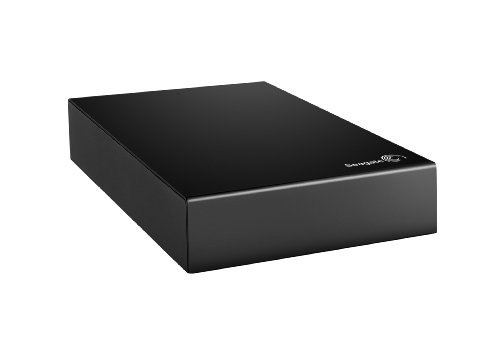Computer See Seagate Expansion 3 TB USB 3.0 Desktop External Hard Drive STBV3000100 Details
Product Description
The Seagate Expansion desktop drive provides extra storage for your ever-growing collection of files. Instantly add space for more files, consolidate all of your files to a single location, or free up space on your computer’s internal drive to help improve performance. Setup is straightforward; simply plug in the included power supply and USB cable, and you are ready to go. It is automatically recognized by the Windows operating system, so there is no software to install and nothing to configure. Saving files is easy too—just drag-and-drop. Take advantage of the fast data transfer speeds with the USB 3.0 interface by connecting to a SuperSpeed USB 3.0 port. USB 3.0 is backwards compatible with USB 2.0 for additional system compatibility. Software Requirements: Works with Windows Vista and Windows XP.Sustained Data Transfer Rate: USB 3.0 4.8Gbps. System Requirements: Compatible operating systems are Windows 8, Windows 7, Windows Vista, Windows XP SP3 (32-bit and 64-bit). Inside the Box: External desktop hard drive, USB cable, Quick start guide, Power adapter, 1-year limited warranty.
- Instantly add 3 TB of storage space to your computer
- Simple plug-and-play connectivity via USB cable
- Power supply and USB 3.0 cable included
- USB 3.0 interface for extremely fast data transfer speeds (USB 2.0 compatible)
- Drive is automatically recognized by Windows; no software installation required
More About Seagate Expansion 3 TB USB 3.0 Desktop External Hard Drive STBV3000100
In the beginning, computer memory was created. It was fundamental in its architecture and really rough compared to the computer memory of today. The time was the 1940s and 1950s. As sock hops entertained the children of that generation, the birth of computers and computer memory emerged to the usage of businesses and massive companies. Virtual memory was nonetheless a dream that hadn't had a chance to be dreamt and the speeds at And this the memory had to be accessed hadn't reached above a turtle's crawl compared to today's standards.
Logic and simplified algorithms were the hot Products of those day and technologies brightest star. All massive programs, Which when compared to the today's pieces of software would nonetheless have been tiny, had to have them in order to procedure and Manage two level storage-primary storage and secondary storage.
Then, the subsequent stage of technology spurred from one the depths of the meager beginnings and virtual memory was born. The technology that created virtual memory didn't have the intent of extending primary memory, but rather of Making such an extension possible and relatively easy for programmers to use given that the initial computers were outgrown rapidly by the working world. It didn't take long to figure out that increasing what a computer can frequently do would increase the capability of company to create a profit and grow to be a household name.
The wide range of jobs that the computer can often do was seen in the getting started as limited. with technological advancement, that view swiftly moved to limitless. This shift at the possibilities of computer memory and in computers themselves led to a technological explosion as each and every aspect of each and every conceivable probability and possibility found their way in to the think tanks of programmers and developers intent on growing the functionality of those computer.
The 1960s saw even much more development, with other particular strides in virtual memory. The B5000 hit the market With the new technology and was designed for organization use, not personal use. Personal usage of computers waited at the wings, though it had not been the original intent when the development of computers began.
In 1969, virtual memory finally graduated from a buggy concept along with other several issues with a heavy cost tag attached. IBM researched and proved its advantageous capabilities, moving virtual memory from one infancy to toddlerhood without having any further delays.
The 1970s saw the development of the minicomputers. These, of course, were not the minicomputers of today, but rather big in comparison. Still, they were the smallest computers of their day. The NORD1 didn't do badly at all around the market. The birth of those idea of a personal computer became the concentrate of these decade.
now that the 70s, there are already so multiple changes Using the way computers were used, how they store and hold memory, and at the same time the purpose of computers. The late 70s and early 80s saw the computer begin the personal trek since it showed up in homes. No longer just for business, these computers were quite limited in their ability. The very first personal computers ran just a couple of computer applications and didn't have significantly functionality for Creating the volume of work needed for home offices. By the 90s, this flaw would be rectified as the personal computer became a Common and ordinary addition to homes.
By the 2000s, the home computer produced just as much revenue from one business, created a new method of shopping and balancing finances as their business counterparts. many businesses are now men and women on a home computer working With the same amount of competitive edge as companies who began the technological race for computerized functions years ago. As each and every milestone in technology has advanced, so has computer memory. Today, home computers use and possess the capacity to store massive amounts of information. the popularity of computers will only increase as the alternatives in computer memory and other technology continually speeds up the value and functionality of these computer.
Seagate Expansion 3 TB USB 3.0 Desktop External Hard Drive STBV3000100 Reviews
Seagate Expansion 3 TB USB 3.0 Desktop External Hard Drive STBV3000100:Computer





